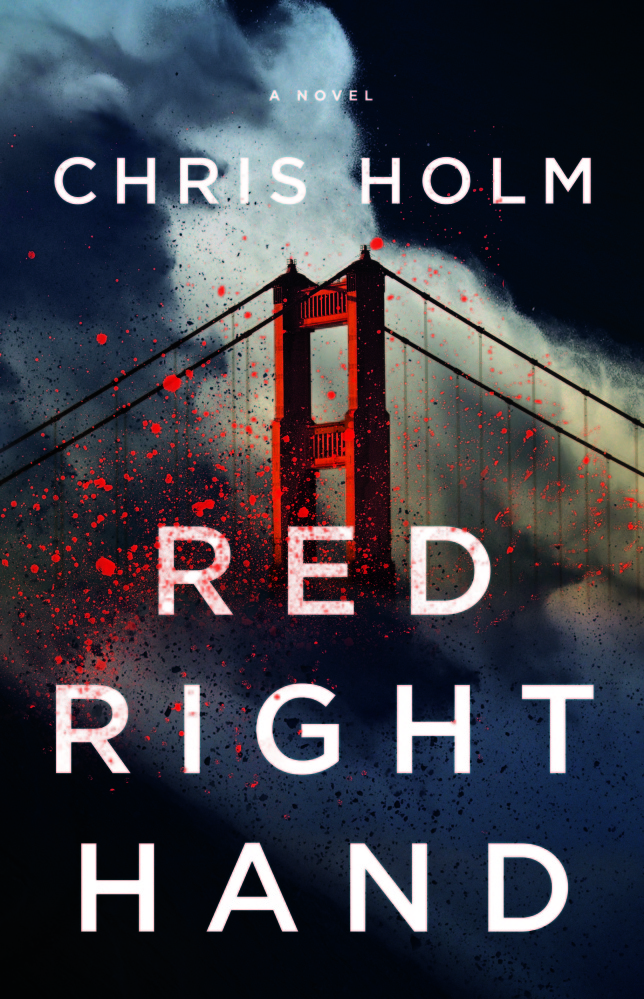Last year, Portland writer Chris Holm inaugurated an exciting new thriller series with “The Killing Kind.” Now he’s back with a second novel featuring Michael Hendricks, the trained assassin who stalks other hit men. The results are similarly explosive.
“Red Right Hand” doesn’t waste any time getting down to business. A family of tourists have their vacation ruined and their lives turned upside down when they pose for a video greeting at the precise moment a tug rams the Golden Gate Bridge’s south tower and explodes. The footage goes viral on social media, but there are some viewers for whom the most pressing question is not “What the hell just happened?” but “Who shot that video?”
The camera operator turns out to be Frank Segreti, a federal witness once willing to testify about the Council, America’s most powerful crime syndicate. Segreti disappeared years ago and has been presumed dead ever since. FBI Special Agent Charlie Thompson recognizes him right away, but with all of her colleagues focused on preventing another act of terrorism in San Francisco, she can’t find anyone willing to fetch Segreti and offer him passage to safety.
Having exhausted legal channels, Thompson reaches out to Hendricks, who is waging his own private war against the Council. Still reeling from the brutal death by torture of his friend and tech expert, still hung up on his former fiancé who loved him before he became a killer for hire, Hendricks isn’t playing at the top of his game. He nearly gets himself killed in a botched assassination attempt and survives only thanks to Cameron, a mysterious young woman who aspires to be his protégé. She tells him, “you could use a little tech support. An eye in the sky. A voice in your ear. A ghost in the machine.”
She’s right, of course, and her and Hendricks’ investigation of Segreti’s sudden re-appearance takes them both to San Francisco and into a mission that will push them to physical and emotional extremes.
Second books in a thriller series are tricky. Many authors simply want to bank on the story elements that worked before, while somehow upping the stakes and adding some hopefully unexpected twists. Sometimes, however, the need for the new makes the plot too frenetic. In other instances, callbacks to the first novel can overwhelm the follow-up and make the narrative feel static and over-explained.
The author of the “Collector” series of fantasy pulp adventures, Holm mostly avoids those pitfalls. While there’s no absolute prerequisite to read the first installment in the series before beginning the second, the set-up of “Red Right Hand” flows directly from “The Killing Kind” and allows Holm to start the story with a bit of clever misdirection. Returning readers will understand why Hendricks isn’t the same man he was at the end of “The Killing Kind,” but newcomers will quickly see how he reconciles his existence as a “bad” man who does “good” things.
In the wake of the attack on the Golden Gate Bridge, Hendricks muses, “When war became big business, shareholders were bound to demand more of it, regardless of how many young men and women it left abandoned, rudderless, adrift. Too many of them found solace in extremism, only to discover the life vest they’d been tossed was laced with explosives, and thus the beast was fed again.” Hendricks has to acknowledge that, with his own vendetta against the Council, he helps perpetuate a cycle of violence.
The introduction of Cameron as a new sidekick works well. Although possessing a dry sense of humor, Hendricks is too intense a protagonist to be the point of view character for every chapter. Plot logistics also demand that Hendricks can’t completely be a lone wolf or an omnicompetent superhero, that he needs someone to back him up with technical expertise and moral support. Cameron fits the bill nicely.
If there’s an aspect of “Red Right Hand” that doesn’t quite live up to the previous volume, it lies in the choice of villain. The book’s boorish but dangerous antagonist, Yancey, isn’t quite the equal of suave and self-confident Engelmann, Hendricks’ nemesis from “The Killing Kind.” But Yancey serves his purpose by keeping Hendricks, Cameron and Segreti in an elevated state of jeopardy all the way to the end.
Holm gets most of the details right in his depiction of San Francisco and environs, centering much of the action around the Presidio, the military base turned national park close to the Golden Gate Bridge. He stages a climactic showdown aboard a Bay Area Rapid Transit car. While the scene is choreographed for maximum suspense, when Yancey brags that “one of my company’s subsidiaries operates the security cameras for the entire (expletive) BART system,” it may elicit a bemused chuckle from San Francisco Bay Area residents. BART is notorious for video cameras that are either decoys or simply don’t work.
In “Red Right Hand,” Holm succeeds in developing Michael Hendricks as a complexly conflicted protagonist, while keeping the level of action and intrigue running high. Smart, unpredictable and well-constructed, the novel is a worthy follow-up to “The Killing Kind,” a satisfying thriller on its own terms and likely a harbinger of pulse-quickening adventures still to come.
Berkeley writer Michael Berry is a Portsmouth, New Hampshire, native who has contributed to Salon, the San Francisco Chronicle, New Hampshire Magazine, the Los Angeles Review of Books and many other publications. He can be contacted at:
mikeberry@mindspring.com
Twitter: mlberry
Send questions/comments to the editors.




Success. Please wait for the page to reload. If the page does not reload within 5 seconds, please refresh the page.
Enter your email and password to access comments.
Hi, to comment on stories you must . This profile is in addition to your subscription and website login.
Already have a commenting profile? .
Invalid username/password.
Please check your email to confirm and complete your registration.
Only subscribers are eligible to post comments. Please subscribe or login first for digital access. Here’s why.
Use the form below to reset your password. When you've submitted your account email, we will send an email with a reset code.